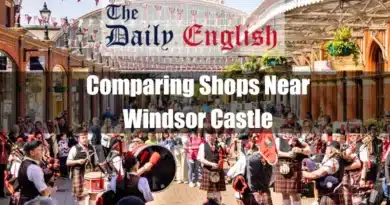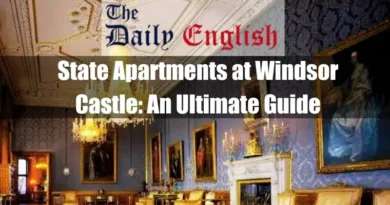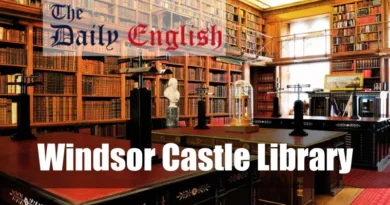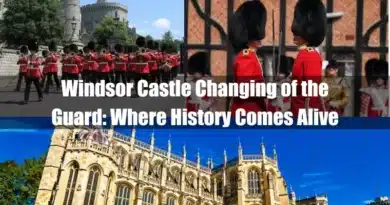I. Introduction
Tucked away within Windsor Castle lies the Moat Room, a space dedicated to showcasing the castle’s remarkable history. This informative room features unique exhibits: a detailed bronze medal depicting Windsor Castle’s grandeur in 1377, transporting visitors back in time. Complementing this is the Monarch’s Timeline, adorning the walls and visually chronicling the reigns of all the English and British monarchs associated with the castle. Through these exhibits, the Moat Room offers a glimpse into Windsor Castle’s evolution from a medieval fortress to a cherished royal residence.
While details on the exact size and design elements are unavailable, the Moat Room offers a captivating glimpse into Windsor Castle’s history.
II. Moat Room: A Historical Orientation
Nestled amongst the State Apartments of Windsor Castle, possibly serving as a waiting area for visitors, lies the Moat Room, dedicated to illuminating the castle’s fascinating past. While the exact date of its construction remains unknown, it’s believed to be part of the extensive renovations undertaken by King George IV in the early 19th century. These renovations aimed to transform the State Apartments into a grand and opulent space befitting the British monarchy.
III. Delving into the Design
While specifics of the Moat Room’s design remain unclear, the space itself serves a clear purpose: to illuminate Windsor Castle’s history. The architectural style could possibly reflect the simplicity favoured in the early 19th century, potentially incorporating clean lines and symmetrical elements. This focus on order and formality might befit a room dedicated to historical exploration.
Also, read:
- East Terrace Garden, Windsor Castle
- The Round Tower, Windsor Castle
- The State Courtyard, Windsor Castle
IV. The Centerpiece: Unveiling the 1377 Bronze Model

A. A Window to the Past: The Significance of the Model
The undisputed centrepiece of the Moat Room at Windsor Castle is the awe-inspiring large-scale bronze model of Windsor Castle. This intricate and detailed model offers visitors a unique opportunity to step back and witness the castle’s grandeur during a specific period – 1377.
1. Depiction of Medieval Windsor Castle
The 1377 date holds historical significance. It coincides with the reign of King Edward III, a pivotal period in English history marked by territorial expansion and architectural advancements. The model meticulously recreates the castle’s appearance during this era, showcasing its imposing fortifications, sprawling courtyards, and towering structures.
Visitors can better understand the castle’s role as a medieval fortress by examining the model. The formidable walls, strategically placed towers, and presence of drawbridges all speak to the castle’s primary function—to provide a secure refuge for the monarch and his court during the conflict.
The model also sheds light on the castle’s residential aspects. Grand halls, private chambers, and elaborate gardens depicted in the model hint at the luxurious lifestyle enjoyed by the royal family within the castle walls.
2. Historical Context: Understanding the 1377 Era
To fully appreciate the significance of the 1377 model, it’s important to consider the historical context of the period. The Hundred Years’ War marked the reign of King Edward III (1327-1377), a prolonged conflict between England and France. The ever-present threat of invasion during this period underscores the importance of Windsor Castle’s defensive capabilities, represented in the model.
Furthermore, the 14th century witnessed significant advancements in architectural techniques. The model allows visitors to see how these advancements were incorporated into the design of Windsor Castle, potentially including features like larger windows, more elaborate fireplaces, and improved roofing techniques.
Also, read:
- Windsor Castle Opening Times: Everything You Need to Know.
- Windsor Castle Tickets: A Proven Comprehensive Guide.
- Windsor Castle Changing of the Guard: Where History Coming Alive.
- Windsor Castle Tour: A Comprehensive and Best Guide.
- Windsor Castle Tickets Advantage Card: Know Everything.
B. A Closer Look at the Model’s Details
1. Architectural Features Represented
The 1377 bronze model is a treasure trove of architectural details, providing valuable insights into the castle’s design and construction. Key features to explore in the model include:
- The Round Tower: A prominent landmark within the castle complex, the Round Tower served as a formidable keep and a symbol of royal authority.
- The State Apartments: These grand apartments housed the royal family and visiting dignitaries, offering a glimpse into the opulent lifestyle enjoyed by the elite.
- St. George’s Chapel: This magnificent chapel, a centrepiece of the castle, is meticulously recreated in the model, showcasing its intricate Gothic architecture.
- Defensive Fortifications: The model depicts the castle’s defensive features, including walls, towers, and drawbridges, highlighting its role as a crucial military stronghold.
2. Storytelling Through Details: Daily Life and Defense
Beyond the architectural details, the 1377 model also offers a glimpse into the daily life and activities within the castle walls during the 14th century. By scrutinising the model, visitors might be able to discern details such as:
- Activity in the courtyards: The figures on the model could depict soldiers’ training, merchants conducting trade, or even courtly entertainment.
- Details on the buildings: Looking closely at the model, one might observe features like chimneys, kitchens and hearths, or ornately decorated windows, hinting at the grandeur of specific chambers.
- Defensive preparations: The model could showcase details like weapons stockpiles or soldiers manning the battlements, providing insight into the constant vigilance required during wartime.
By examining these intricate details, the 1377 bronze model becomes a captivating storyteller, transporting visitors to experience the vibrant life within the castle walls during a pivotal period in English history.
Also, read:
- Exploring Buckingham Palace to Windsor Castle Journey.
- How Far is Windsor Castle from Buckingham Palace? Royal Mile?
- How to Get to the Windsor Castle from London
- Who Lives in the Windsor Castle?
V. A Journey Through Time: The Monarch’s Timeline

The Moat Room at Windsor Castle offers a unique opportunity to explore the castle’s history through two distinct yet interconnected exhibits: the awe-inspiring 1377 bronze model and the captivating Monarch’s Timeline. Part II focused on the model, providing a window into the castle’s appearance during a specific era. Now, we focus on the timeline, a visual representation of the castle’s evolution throughout its long and fascinating history.
A. The Tapestry of Reigns: Unveiling the Timeline
Running along the length of the Moat Room, the Monarch’s Timeline serves as a visual tapestry woven from the threads of successive reigns. It chronologically lists all the monarchs who have played a part in Windsor Castle’s rich history, from William the Conqueror in the 11th century to the present.
1. The Concept of the Timeline: A Visual Representation of History
The timeline is a powerful learning tool, allowing visitors to grasp the vast expanse of time encompassed by Windsor Castle’s existence. By simply glancing at the timeline, one can appreciate the sheer number of monarchs who have walked the castle’s halls, each leaving their mark on its development and character.
The timeline goes beyond simply listing names. It might include additional details, such as the reign dates of each monarch, allowing visitors to connect specific historical periods with the corresponding development of the castle. In some cases, the timeline might even incorporate portraits of the monarchs, further personalising the historical narrative.
2. Significance of Highlighting Reigning Monarchs
Windsor Castle has served as a royal residence for a staggering 39 monarchs. The Monarch’s Timeline underscores the profound connection between the castle and the British crown. By highlighting the reigning monarchs, the timeline emphasises the castle’s enduring role as a seat of power and a symbol of the monarchy’s legacy.
Furthermore, the timeline allows visitors to consider the impact of individual monarchs on the castle’s development. Certain rulers undertook significant building projects, renovations, or additions to the castle, shaping its architectural landscape. The timeline, when coupled with additional information, can act as a springboard for further exploration into the specific contributions of each monarch to Windsor Castle’s evolution.
Also, read:
- Are Babies Free for Windsor Castle
- Are Dogs Allowed into Windsor Castle
- Comparing Shops Near Windsor Castle
B. Interweaving the Timeline with the Model
The Moat Room’s true brilliance lies in how the exhibits complement each other. The 1377 bronze model offers a snapshot of the castle during a specific reign, while the Monarch’s Timeline provides a broader historical context. Visitors can better understand the castle’s transformation by studying both exhibits together.
1. Tracing the Castle’s Evolution Through Monarchs
Imagine a visitor studying the model and then glancing at the timeline. They might notice features on the model, such as a newly constructed wing or a modified fortification, and then identify the corresponding monarch on the timeline who might have been responsible for that change. This cross-referencing allows a more nuanced understanding of how the castle’s physical form evolved alongside successive monarchs’ changing needs and priorities.
2. Highlighting Key Periods of Development
The timeline can also guide visitors towards specific periods of significant development for Windsor Castle. For instance, the reign of Henry II in the 12th century witnessed the construction of the stone keep, a pivotal moment in the castle’s transformation from a wooden motte-and-bailey structure to a more robust stone fortification. By identifying such key moments on the timeline and then examining the corresponding features on the model, visitors can gain a deeper appreciation for the castle’s architectural journey.
Also read:
- The Mystery of 2 Windsor Castles
- Are There Guided Tours of Windsor Castle
- Are There Mice in Windsor Castle
VI. The Moat Room’s Impact: A Learning Experience

The Moat Room at Windsor Castle transcends a simple exhibition space. The Moat Room is a gateway to historical exploration through its meticulously curated exhibits. It sparks curiosity and ignites a deeper understanding of the castle’s rich past.
A. A Gateway to Understanding Windsor Castle’s History
1. Educational Value for Visitors
The Moat Room is open to visitors of all ages and backgrounds. The bronze model offers a visually captivating starting point, allowing even younger visitors to grasp the scale and grandeur of the castle. With its clear presentation of historical information, the timeline caters to those seeking a more in-depth understanding of the castle’s evolution.
For history buffs, the Moat Room provides a springboard for further exploration. By piquing their interest with the exhibits, the room encourages visitors to delve deeper into specific historical periods, architectural styles, or the lives of individual monarchs associated with the castle.
2. The Moat Room as a Historical Spark
The Moat Room’s impact goes beyond mere information dissemination. The exhibits have the potential to spark a genuine curiosity about history. By showcasing the castle’s transformation over time, the Moat Room encourages visitors to consider the lives of those who inhabited its walls and the events that unfolded within its grounds. This newfound curiosity can lead to further exploration of British history, perhaps inspiring visitors to delve into books, documentaries, or even guided tours of the castle itself.
Also, read:
- Are There Stables at Windsor Castle
- Are There Steps, Elevators or Lifts in Windsor Castle
- Are There Women in the Coldstream Guards at Windsor Castle
B. Thematic Connections: Linking the Moat Room to the Castle
The Moat Room’s brilliance lies in its exhibits and how it connects visitors to the broader experience of exploring Windsor Castle.
1. Reflecting the Castle’s Purpose: Defense and Residence
The Moat Room’s exhibits mirror Windsor Castle’s dual purpose—a place of defence and a royal residence. The 1377 bronze model showcases the castle’s formidable fortifications, reminding visitors of its critical role in safeguarding the monarchy during turbulent times. On the other hand, the Monarch’s Timeline emphasises the castle’s function as a royal residence, highlighting the lives of the monarchs who have called it home.
2. Showcasing Artistic and Technological Advancements
By examining the 1377 bronze model, visitors can gain insights into that period’s architectural styles and construction techniques. The intricate details on the model, from the design of the towers to the ornamentation of the buildings, offer a glimpse into the artistic and technological advancements of the 14th century.
This connection between the Moat Room and the actual castle allows visitors to see these historical concepts come to life within the grand halls and fortified walls they explore during their tour.
Also, read:
- Devastating Timeline of the Windsor Castle Fire 1992.
- The Windsor Castle Fire 1992: A Historical Catastrophe.
- The Windsor Castle Fire Salvage Operation 1992.
- The Extent of Damage to Windsor Castle Due to the 1992 Fire.
- Restoration of Windsor Castle after Devastating Fire in 1992.
VII. Beyond the Moat Room: Exploring Further
The Moat Room is an enticing introduction to Windsor Castle’s vast and fascinating history. By igniting curiosity and providing a foundational understanding, the room encourages visitors to embark on a deeper exploration of the castle itself. Walking through the State Apartments, exploring St. George’s Chapel, or venturing onto the castle walls allows visitors to experience firsthand the architectural details, historical significance, and enduring legacy showcased in the Moat Room exhibit.
For those seeking to delve even further, the Royal Collection Trust website offers a wealth of information on Windsor Castle’s history, architecture, and art collections. Additionally, recommended books and documentaries can provide a deeper understanding of specific historical periods or the lives of individual monarchs associated with the castle. The Moat Room, therefore, serves as a springboard for a lifelong journey of discovery into the captivating story of Windsor Castle.










Comments are closed.